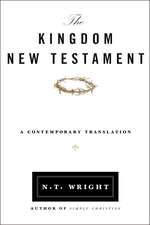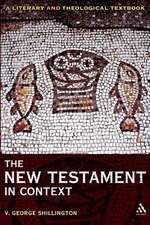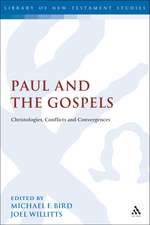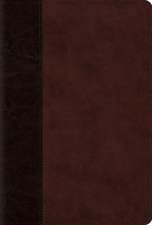Paul's Utilization of Preformed Traditions in 1 Timothy: An evaluation of the Apostle's literary, rhetorical, and theological tactics: The Library of New Testament Studies
Autor Prof. Mark M. Yarbroughen Limba Engleză Paperback – 26 iun 2019
Mark Yarbrough assesses the question of whether traditional 'preformed' material contributes to the message and understanding of Paul's first letter to Timothy. The issue is addressed in three sections. Part one evaluates previous works interacting with 'traditional' material in the New Testament. Through a critique of historically proposed criteria, Yarbrough identifies eight criteria as the primary tools by which to discern units of preformed material.
In the second part of the book Yarbrough evaluates nineteen passages in 1 Timothy according to the criteria previously determined. From this base he embraces twelve of the nineteen passages as preformed material. These passages are subsequently examined in depth according to the author's distinct methodology. Part three demonstrates four functions of the preformed traditions in 1 Timothy. Firstly, that they may be seen as strengthening the literary cohesion of the letter. Secondly, that the traditional units afford the author rhetorical leverage which may be best identified as the provision of authority, the establishment of an instant rapport with the primary audience, and the assistance conferred in addressing this implied audience. Thirdly, they present theological directives that confront the character and belief of the false teachers.
Finally, Yarbrough asserts that the preformed traditions exist as a combatant against counter-mission doctrine. In conclusion, this study displays that the traditional material which may be discerned within the letter contributes significantly to the overall message and understanding of 1 Timothy.
| Toate formatele și edițiile | Preț | Express |
|---|---|---|
| Paperback (1) | 222.16 lei 3-5 săpt. | +13.43 lei 6-10 zile |
| Bloomsbury Publishing – 26 iun 2019 | 222.16 lei 3-5 săpt. | +13.43 lei 6-10 zile |
| Hardback (1) | 949.56 lei 6-8 săpt. | |
| Bloomsbury Publishing – 9 dec 2009 | 949.56 lei 6-8 săpt. |
Din seria The Library of New Testament Studies
- 34%
 Preț: 509.52 lei
Preț: 509.52 lei - 22%
 Preț: 832.58 lei
Preț: 832.58 lei - 22%
 Preț: 832.09 lei
Preț: 832.09 lei - 24%
 Preț: 190.33 lei
Preț: 190.33 lei - 22%
 Preț: 832.65 lei
Preț: 832.65 lei - 23%
 Preț: 191.31 lei
Preț: 191.31 lei -
 Preț: 221.70 lei
Preț: 221.70 lei -
 Preț: 98.92 lei
Preț: 98.92 lei - 31%
 Preț: 830.87 lei
Preț: 830.87 lei - 22%
 Preț: 834.60 lei
Preț: 834.60 lei - 22%
 Preț: 831.59 lei
Preț: 831.59 lei - 30%
 Preț: 717.05 lei
Preț: 717.05 lei - 22%
 Preț: 835.03 lei
Preț: 835.03 lei - 30%
 Preț: 511.40 lei
Preț: 511.40 lei - 24%
 Preț: 190.33 lei
Preț: 190.33 lei -
 Preț: 158.77 lei
Preț: 158.77 lei - 30%
 Preț: 510.04 lei
Preț: 510.04 lei - 22%
 Preț: 832.99 lei
Preț: 832.99 lei - 30%
 Preț: 509.52 lei
Preț: 509.52 lei - 22%
 Preț: 832.80 lei
Preț: 832.80 lei - 22%
 Preț: 831.76 lei
Preț: 831.76 lei - 22%
 Preț: 834.93 lei
Preț: 834.93 lei - 22%
 Preț: 831.59 lei
Preț: 831.59 lei - 22%
 Preț: 832.41 lei
Preț: 832.41 lei - 22%
 Preț: 832.99 lei
Preț: 832.99 lei -
 Preț: 414.71 lei
Preț: 414.71 lei - 30%
 Preț: 773.65 lei
Preț: 773.65 lei - 22%
 Preț: 834.93 lei
Preț: 834.93 lei - 14%
 Preț: 511.81 lei
Preț: 511.81 lei - 30%
 Preț: 775.67 lei
Preț: 775.67 lei - 30%
 Preț: 1012.49 lei
Preț: 1012.49 lei - 30%
 Preț: 509.02 lei
Preț: 509.02 lei - 30%
 Preț: 656.90 lei
Preț: 656.90 lei -
 Preț: 469.92 lei
Preț: 469.92 lei -
 Preț: 471.68 lei
Preț: 471.68 lei -
 Preț: 173.21 lei
Preț: 173.21 lei - 30%
 Preț: 833.64 lei
Preț: 833.64 lei - 22%
 Preț: 834.93 lei
Preț: 834.93 lei - 31%
 Preț: 772.17 lei
Preț: 772.17 lei - 30%
 Preț: 774.20 lei
Preț: 774.20 lei - 14%
 Preț: 1124.92 lei
Preț: 1124.92 lei - 22%
 Preț: 948.51 lei
Preț: 948.51 lei - 14%
 Preț: 1128.84 lei
Preț: 1128.84 lei - 31%
 Preț: 1065.91 lei
Preț: 1065.91 lei - 22%
 Preț: 777.71 lei
Preț: 777.71 lei - 31%
 Preț: 1064.84 lei
Preț: 1064.84 lei - 22%
 Preț: 1063.44 lei
Preț: 1063.44 lei - 22%
 Preț: 889.49 lei
Preț: 889.49 lei - 22%
 Preț: 1006.06 lei
Preț: 1006.06 lei
Preț: 222.16 lei
Nou
Puncte Express: 333
Preț estimativ în valută:
42.52€ • 46.17$ • 35.71£
42.52€ • 46.17$ • 35.71£
Carte disponibilă
Livrare economică 02-16 aprilie
Livrare express 18-22 martie pentru 23.42 lei
Preluare comenzi: 021 569.72.76
Specificații
ISBN-13: 9780567689245
ISBN-10: 0567689247
Pagini: 256
Dimensiuni: 156 x 234 x 17 mm
Greutate: 0.35 kg
Editura: Bloomsbury Publishing
Colecția T&T Clark
Seria The Library of New Testament Studies
Locul publicării:London, United Kingdom
ISBN-10: 0567689247
Pagini: 256
Dimensiuni: 156 x 234 x 17 mm
Greutate: 0.35 kg
Editura: Bloomsbury Publishing
Colecția T&T Clark
Seria The Library of New Testament Studies
Locul publicării:London, United Kingdom
Caracteristici
Establishes a sound methodology for discerning what constitutes an inserted unit of traditional material.
Cuprins
1. Introduction (Scope, Focus, Need, Organization, Limitations)
2. Taxonomy and Identification Criteria for Preformed Traditions
Taxonomy
Pauline Taxonomical Examples
Identification Criteria
Synthesis and Preferential Criteria
Methodology of Criteria Identification and Evaluation
Method of Evaluation
3. Identification of Preformed Traditions in 1 Timothy
1 Timothy Chapter 1
1 Timothy Chapter 2
1 Timothy Chapter 3
1 Timothy Chapter 4
1 Timothy Chapter 5
1 Timothy Chapter 6
4. Paul's Utilization of Preformed Traditions in 1 Timothy
Preformed Traditions and the Strengthening of Literary Cohesion
Preformed Traditions and the Provision of Rhetorical Leverage
Preformed Traditions and the Presentation of Theological Directives against the Opponents
Preformed Traditions and the Argument of 1 Timothy: Combat Counter-Mission Doctrine
5. Conclusion
2. Taxonomy and Identification Criteria for Preformed Traditions
Taxonomy
Pauline Taxonomical Examples
Identification Criteria
Synthesis and Preferential Criteria
Methodology of Criteria Identification and Evaluation
Method of Evaluation
3. Identification of Preformed Traditions in 1 Timothy
1 Timothy Chapter 1
1 Timothy Chapter 2
1 Timothy Chapter 3
1 Timothy Chapter 4
1 Timothy Chapter 5
1 Timothy Chapter 6
4. Paul's Utilization of Preformed Traditions in 1 Timothy
Preformed Traditions and the Strengthening of Literary Cohesion
Preformed Traditions and the Provision of Rhetorical Leverage
Preformed Traditions and the Presentation of Theological Directives against the Opponents
Preformed Traditions and the Argument of 1 Timothy: Combat Counter-Mission Doctrine
5. Conclusion
Recenzii
Reviewed in the Religious Studies Review.
Reviewed in Recensions Et Comptes Rendus-Vol. 63/3.
"Does traditional material contribute to the message and understanding of 1 Timothy, asks Yarbrough, and seeks an answer within the assumption that such material was formulated before an epistle was written, and expressed the Christian community's conviction, or tradition. He surveys criteria used to evaluate traditional material and identifies eight of them as primary. Then he applies them to 19 passages that potentially preceded Paul's use of them, and demonstrates four functions of identified preformed traditions in the epistle." -Eithne O'Leyne, BOOK NEWS, Inc.
"Based on a doctoral dissertation presented to Dallas Theological Seminary in 2008, this volume contends that performed traditions (that is, material that was formulated prior to an epistle's writing and was expressive of the Christian community's conviction) strengthen 1 Timothy's literary cohesion and provide rhetorical leverage in stating theological directives that combat counter-mission doctrine. After a sixteen-page introduction, it considers taxonomy and identification criteria for performed traditions. Next it identifies performed traditions in 1 Tim 1:8-10; 1-15a-b; 1:17; 2:5-6a; 3:1; 3:16; 4:8; 4:9, 10b; 5:24-25; 6:7, 6:10a; and 6:11-16. Then it demonstrates four functions of identified preformed traditions in 1 Timothy: strengthening literary cohesion, providing rhetorical leverage, presenting theological directives against opponents, and combating counter-mission doctrine. Four appendixes are included." -New Testament Abstracts, Vol. 54
Yarbrough's work enhances the impression that the author of 1 Timothy is a writer of some skill: he has judiciously combined material from early Christian worship, creeds, and stories along with a wide array of (Pauline) sayings, letters, and biographical accounts in order to increase the authoritative force of the letter.
'The earlier part of the work examines the significance of preformed material and offers critieria by which it can be assessed. The major study takes short passages that have been considered to contain such material.' - Donald A Bullen, Liverpool Hope University
Reviewed in Recensions Et Comptes Rendus-Vol. 63/3.
"Does traditional material contribute to the message and understanding of 1 Timothy, asks Yarbrough, and seeks an answer within the assumption that such material was formulated before an epistle was written, and expressed the Christian community's conviction, or tradition. He surveys criteria used to evaluate traditional material and identifies eight of them as primary. Then he applies them to 19 passages that potentially preceded Paul's use of them, and demonstrates four functions of identified preformed traditions in the epistle." -Eithne O'Leyne, BOOK NEWS, Inc.
"Based on a doctoral dissertation presented to Dallas Theological Seminary in 2008, this volume contends that performed traditions (that is, material that was formulated prior to an epistle's writing and was expressive of the Christian community's conviction) strengthen 1 Timothy's literary cohesion and provide rhetorical leverage in stating theological directives that combat counter-mission doctrine. After a sixteen-page introduction, it considers taxonomy and identification criteria for performed traditions. Next it identifies performed traditions in 1 Tim 1:8-10; 1-15a-b; 1:17; 2:5-6a; 3:1; 3:16; 4:8; 4:9, 10b; 5:24-25; 6:7, 6:10a; and 6:11-16. Then it demonstrates four functions of identified preformed traditions in 1 Timothy: strengthening literary cohesion, providing rhetorical leverage, presenting theological directives against opponents, and combating counter-mission doctrine. Four appendixes are included." -New Testament Abstracts, Vol. 54
Yarbrough's work enhances the impression that the author of 1 Timothy is a writer of some skill: he has judiciously combined material from early Christian worship, creeds, and stories along with a wide array of (Pauline) sayings, letters, and biographical accounts in order to increase the authoritative force of the letter.
'The earlier part of the work examines the significance of preformed material and offers critieria by which it can be assessed. The major study takes short passages that have been considered to contain such material.' - Donald A Bullen, Liverpool Hope University











